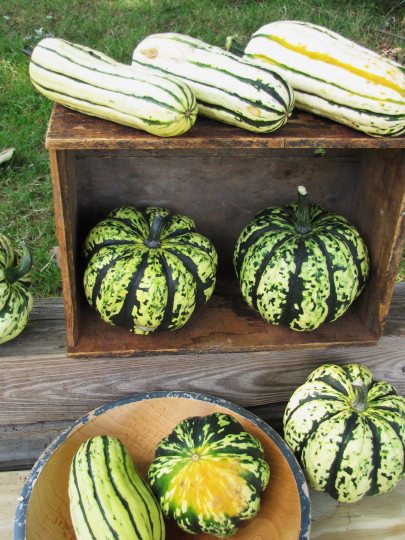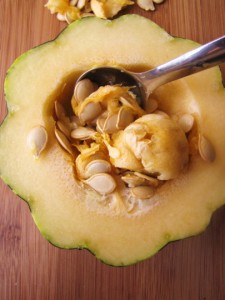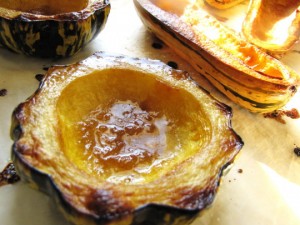 Not every day is a winner in a food writer’s test kitchen. In fact, yesterday was kind of a stinker, if I’m really to be honest. I made some stuffed winter squash which was just—not good. I’ll spare you the details about the stuffing, but I have to tell you, the most frustrating thing was this: The squash were under-ripe. And so, as beautiful as they were raw (see the lovelies at left), the squash were fibrous and bland when cooked. I know—I’m really making you salivate, now, huh?
Not every day is a winner in a food writer’s test kitchen. In fact, yesterday was kind of a stinker, if I’m really to be honest. I made some stuffed winter squash which was just—not good. I’ll spare you the details about the stuffing, but I have to tell you, the most frustrating thing was this: The squash were under-ripe. And so, as beautiful as they were raw (see the lovelies at left), the squash were fibrous and bland when cooked. I know—I’m really making you salivate, now, huh?
I more or less suspected this was the case when I picked the squash in the days leading up to Hurricane Earl. Uh, I mean Tropical Storm Earl. Or maybe Lite & Breezy Earl is more like it. It just didn’t amount to much, but everyone was scurrying around plucking fruit—ripe or not—from vine and tree alike before the storm. I succumbed—before I had solved this dilemma of “how do you tell when winter squash is ripe?”

I know, I am supposed to be a vegetable expert. So I should definitely be hanged (or maybe something less dramatic) for continuing to cook the squash once I cut it open and started digging the seeds out of the hard, pale flesh. I knew for sure then that the squash (especially the Delicatas) were under-ripe. (You’ve probably had this experience with a slightly green butternut squash you’ve bought at the market.) The thing is, in the gardening department, I’m still a neophyte, and try as I might, I haven’t been able to get a straight answer from other gardeners on how to tell when my stripey Carnival and Delicata squash are ripe.
I’ve been told to wait for the stems to wither and dry up on the vine (uh-oh, I am not that patient), and I’ve been told to look for a good spot of orange color on the underside (this didn’t hold true when I cut into the one with color–the one in the bowl in the top photo). But I am beginning to suspect that it is, in fact, a color issue. I looked at pictures of Carnival squash online this morning, and they all had an orange hue on at least half of their surface. And I remember someone telling me a while back that Delicatas are ripe when the green stripes have an orange hue beneath them. So, if you’re color blind (or impatient, like you-know-who), I don’t suggest growing winter squash.
All is not lost, despite my stubborn “I’m going to get this darn thing in the oven anyway” approach yesterday. First, I have more squash in the garden (still ripening, theoretically). Second, I can, in fact, give you quick and easy directions for simple, delicious (unstuffed) roasted acorn squash halves, if you are smarter than me and actually buy your (ripe) squash at the grocery store. (Directions below.) And lastly, if you’ve got a copy of Fast, Fresh & Green on hand, you can turn to page 51 for my absolute favorite acorn squash recipe—Vanilla and Cardamom Glazed Acorn Squash Rings.
And if you don’t have a copy of Fast, Fresh & Green, you’d better get one! The third printing hit last week, and if it’s anything like the first two, copies will be scarce again soon.
———————————————————————————–
 Simple Roasted Acorn Squash Halves
Simple Roasted Acorn Squash Halves
Heat the oven to 400° F. With a very sharp knife, cut a thin sliver off of both ends of the acorn squash, and then cut it in half crosswise. (Cutting the slivers off the ends will help each half sit flat in the baking vessel, rather than rolling around.) Line a shallow baking dish or small heavy sheet pan with foil or parchment paper and arrange the halves in it. Sprinkle them with salt. For each acorn squash you are baking, combine 1 ½ tablespoons of unsalted butter with 1 ½ tablespoons of maple syrup and a small squeeze of lemon (or dash of balsamic vinegar or soy sauce) in a small saucepan. Heat until the butter melts, stir, and brush all over the squash halves. Most of the liquid will pool in the center of the squash; that’s okay—just be sure that you’ve brushed the tops. Bake until very tender and nicely browned, about 1 hour and 10 minutes for a small acorn squash, 10 to 15 minutes more for a larger squash. Baste occasionally if you like. Serve warm as a side dish, one half per person.

Great info about when to pick squash Susie. I have a couple acorn from the local farmer’s market waiting to be cut and cooked now. Congratulations on your 3d printing!
Hi Lee–Hope all is well down your way! Susie
Thank you for the tips! I have two acorns to make as I type..he he! Enjoy!
First, let me say, I absolutely love your book! I am determined to try every recipe in it. Those glazed acorn squash were especially delicious. And now for my question… Lately I have seen a lot of winter squash coming from the local (NC) farms. I picked up a few, mainly because they looked neat, but I want to know more about the different varieties and what I can do with them. Butternut and acorn are of course well covered, but what about the more mysterious ones? Like the bumpy, crook-necked, stripey types? I don’t even know names for most of them!
Hi Robyn! So glad you like the book–that acorn squash recipe is proving very popular! It’s funny you asked about squash, because this weekend I roasted a bunch of different squash and did a taste test on them–I’m going to be blogging about it later in the week or early in the weekend, so stay tuned, because I’ll have advice on how to cook them and what the differences in colors are, etc. (In general, the bumpy crookneck kind are probably gourds, not squash, though there is a very tasty bumpy green squash that’s called buttercup. Stripey probably means delicata (eliptical shaped) or sweet umpling (mini-pumpkin or hourglass shape)–both have sweet, creamy flesh and can be cut in half and roasted at 400 for about an hour and seasoned a variety of ways (classic is butter and maple syrup)….more soon, I promise! thanks